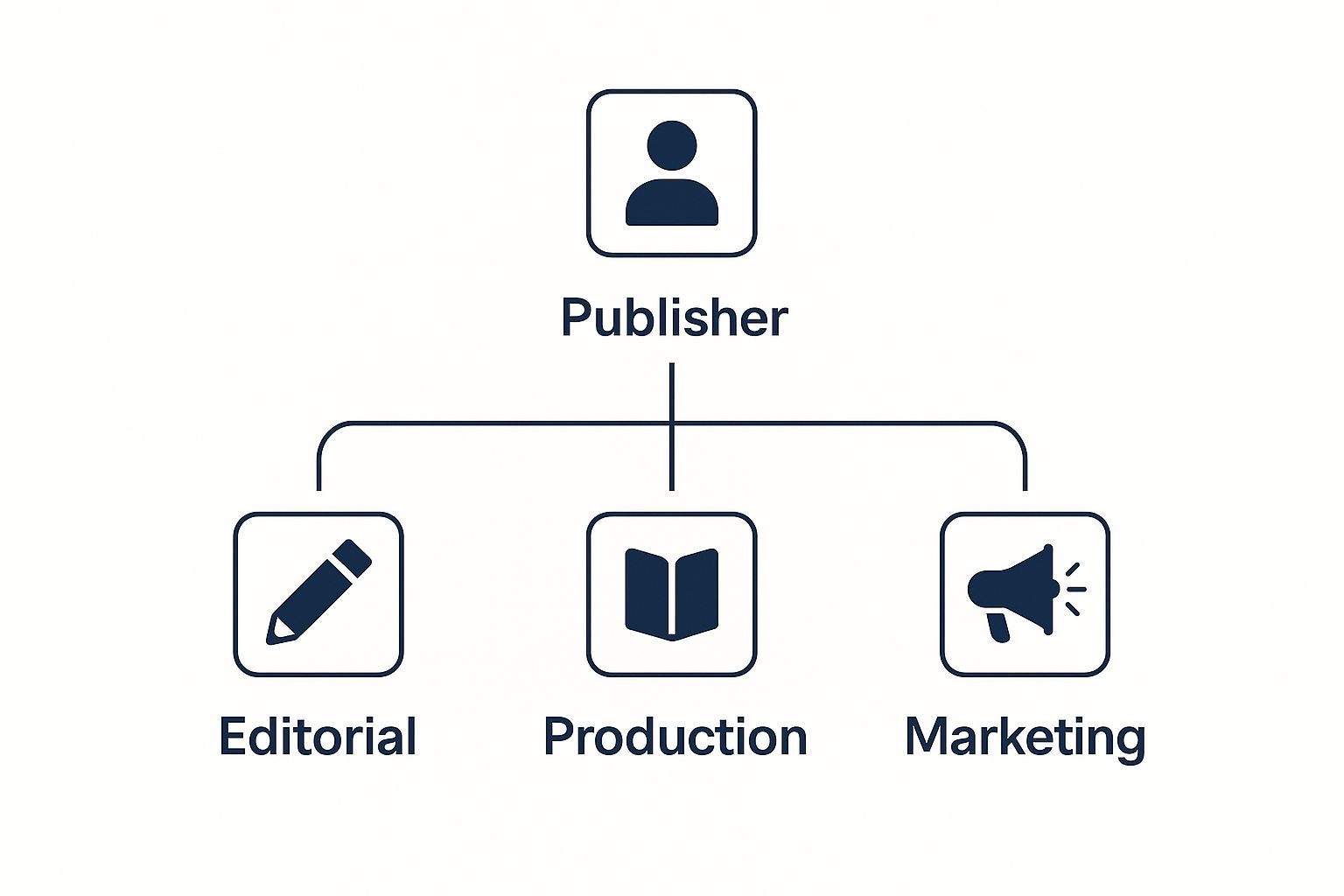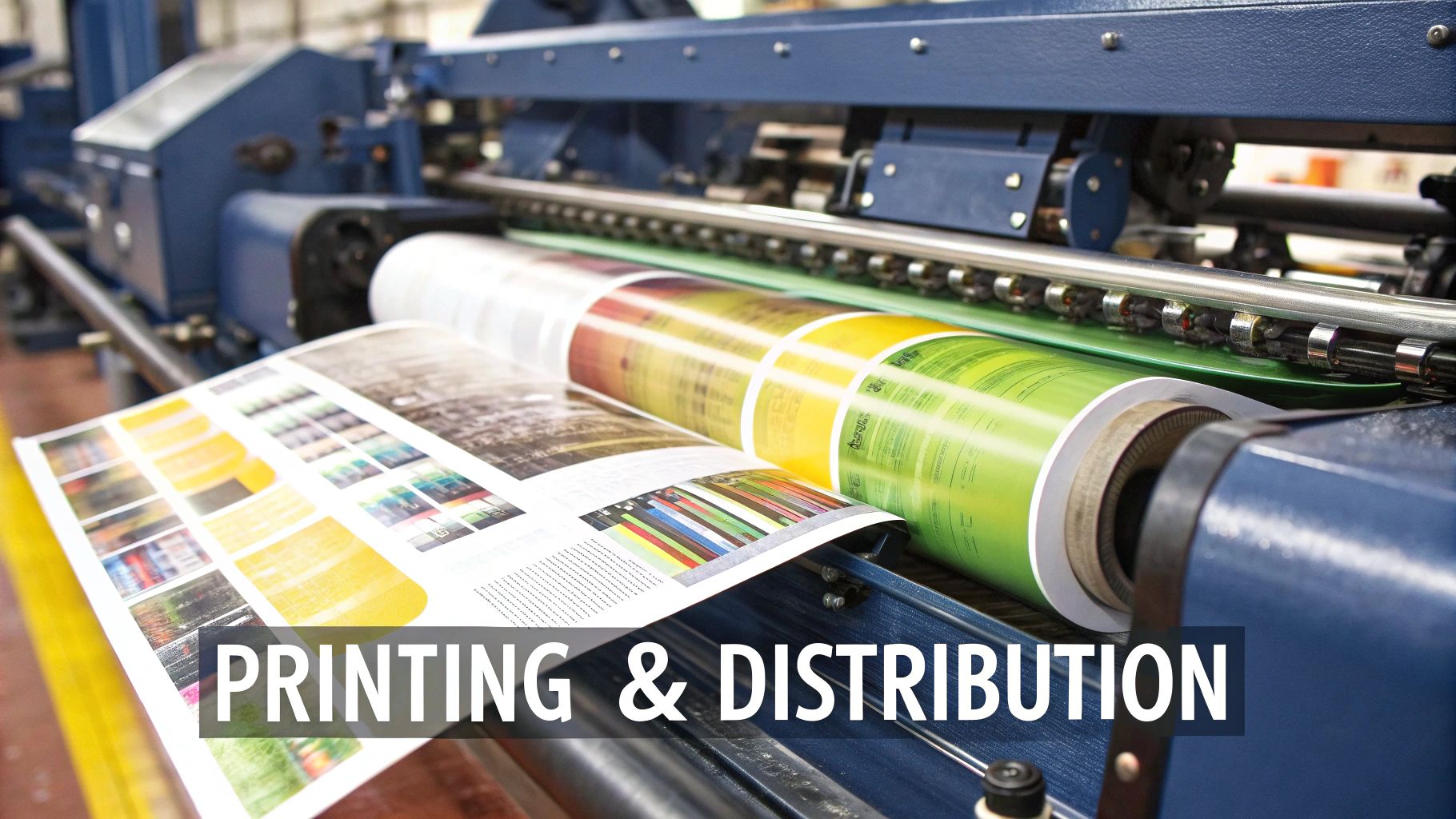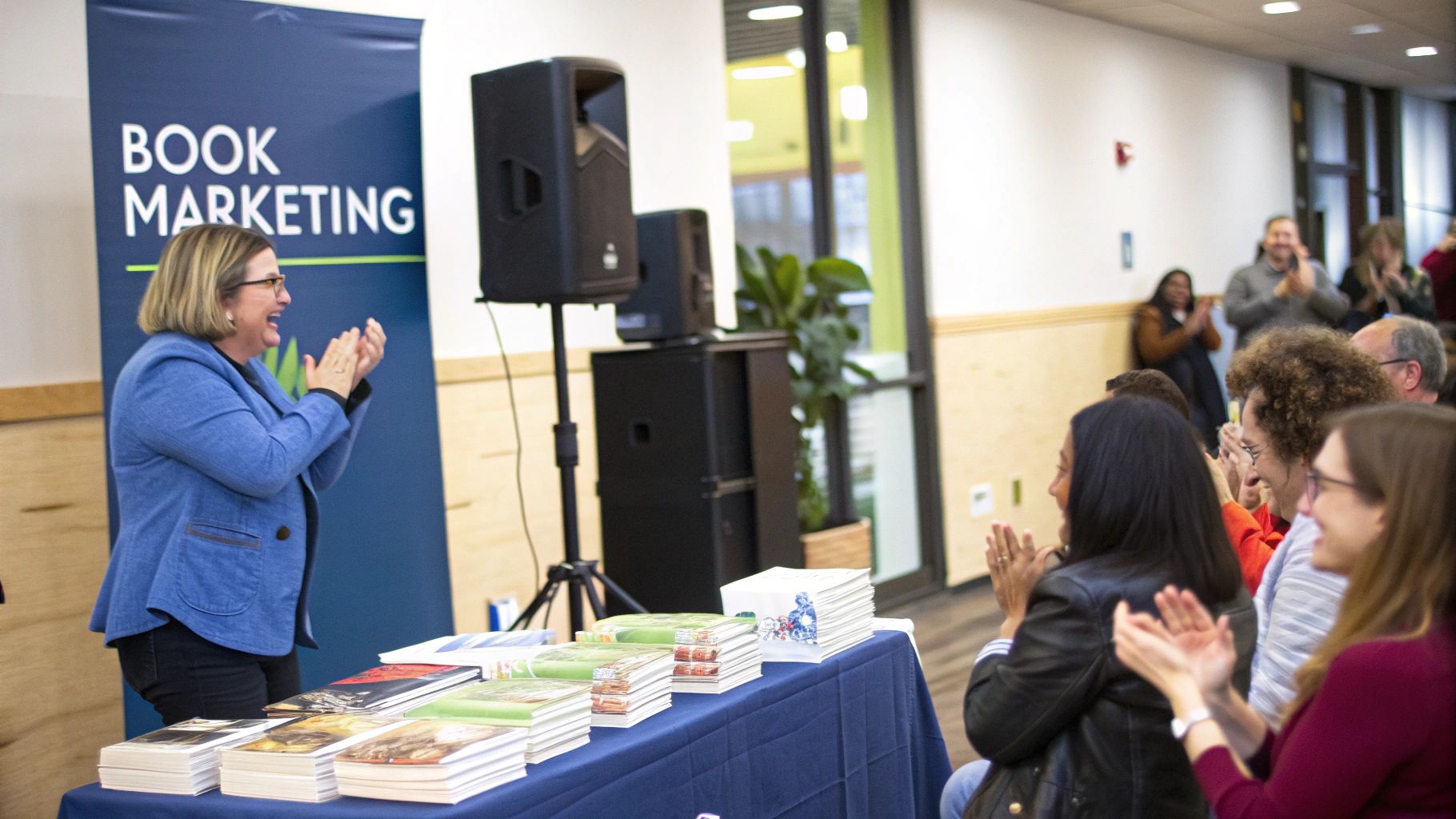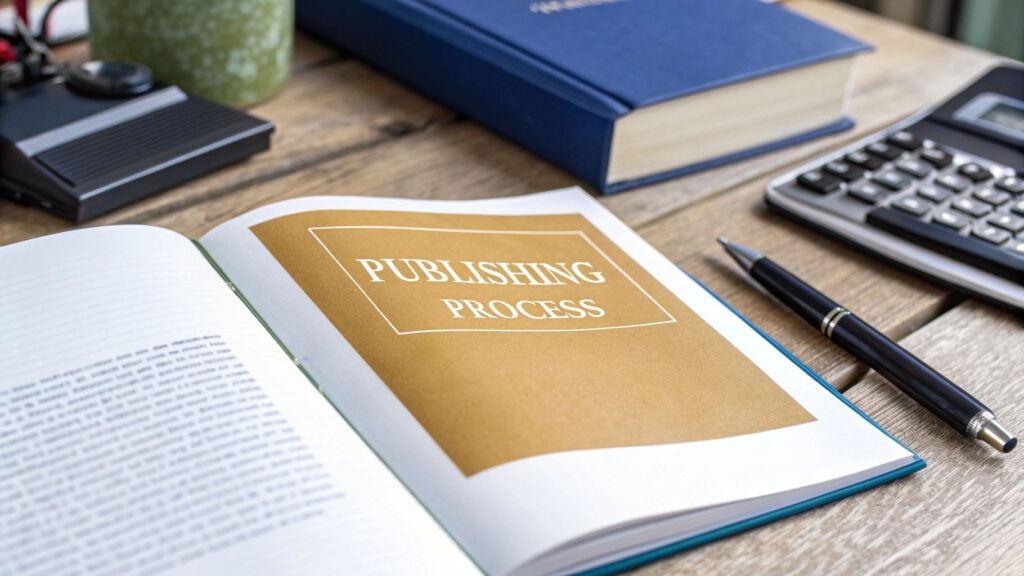So, what exactly is a publisher? Think of them as the strategic partner who takes a manuscript—a writer's vision—and turns it into a real, tangible product. They’re the essential link connecting an author's story with its audience, managing every step to transform a file on a computer into a book people can hold, buy, and love.
The Publisher's Role as a Strategic Partner
It’s easy to get lost in the details, but the best way to understand what a publisher does for a book is to see them as a unique blend of venture capitalist, brand manager, and expert project manager—all for your creative work. A publisher doesn't just print books. They invest a serious amount of money and time into a book’s success, making a calculated bet that it will find its readers and earn back that investment.
This process is a massive undertaking, involving multiple specialized teams working in concert.

As you can see, a publisher coordinates several distinct but connected departments—Editorial, Production, and Marketing—to guide a manuscript from a rough draft to a polished, professional, and commercially successful book.
Core Functions of a Book Publisher
The publisher's work is an all-encompassing journey. They are involved in every single aspect of a book's life, from its raw form as a Word document to its final place on a bookstore shelf.
Here's a breakdown of their primary jobs:
- Acquisition and Curation: This is where it all starts. Editors sift through countless submissions to find manuscripts with real commercial or literary potential that fit their company's brand and mission.
- Editorial Development: Once a book is signed, an editor works closely with the author to hone the story, tighten the structure, and polish the prose until it shines.
- Design and Production: This team creates the book's physical identity. They design an eye-catching cover and a readable interior layout, then oversee the complex process of printing physical copies and creating digital editions.
- Marketing and Publicity: They're responsible for getting the word out. They craft strategic campaigns, pitch the book to media outlets, and work with retailers on promotions to build buzz and drive sales.
- Sales and Distribution: This is the logistics powerhouse. They use their vast networks to get the finished book into the hands of booksellers, both in brick-and-mortar stores and online, across the country and often around the world.
Navigating the modern book market is no small feat, and these functions are crucial for success. The scale of this industry is staggering; the global book publishing market was valued at $97.14 billion and is expected to keep growing. You can dig deeper into these numbers by checking out the analysis on The Business Research Company.
A publisher’s greatest value lies in their ability to amplify an author’s work. They provide the infrastructure, expertise, and market access that an individual author typically cannot achieve alone, turning a personal project into a public phenomenon.
To make this clearer, let's summarize how these functions fit together.
Key Publisher Functions at a Glance
This table breaks down the publisher's main responsibilities at each stage of a book's journey.
| Stage | Publisher's Role | Primary Goal |
|---|---|---|
| Acquisition | Evaluates manuscripts and offers contracts to promising authors. | To build a strong list of commercially viable and high-quality books. |
| Editing | Works with the author to refine the manuscript's content, structure, and writing. | To elevate the manuscript to a professional, publishable standard. |
| Design & Production | Manages cover design, interior layout, printing, and ebook creation. | To create a beautiful, high-quality physical and digital product. |
| Marketing & Publicity | Develops and executes a plan to promote the book to the media and readers. | To generate awareness, create buzz, and drive initial sales. |
| Sales & Distribution | Pitches the book to retailers and manages the supply chain to bookstores. | To ensure the book is available for purchase wherever readers shop. |
Ultimately, each of these roles is designed to give an author's book the best possible chance to succeed in a very crowded marketplace.
Finding and Refining the Next Bestseller

Before a book ever lands in a reader's hands, it has to survive a grueling journey. The very first step is acquisitions, a highly selective process where a publisher sifts through a mountain of manuscripts to find the few with true potential.
Think of an acquisitions editor as a literary talent scout. They’re not just looking for a well-written story; they’re hunting for a manuscript that has both creative spark and real-world commercial viability. It’s a delicate balance of art and business.
Every submission prompts a flood of questions. Is there a ready-made audience for this? Does this book align with our brand? Is the market hungry for this story right now? A publisher is making a serious financial bet with every book they sign, so these questions are anything but trivial.
The Art and Science of Manuscript Curation
Spotting a future bestseller isn't about luck. Editors live and breathe market trends and reader tastes, developing an almost sixth sense for what will resonate. They're constantly networking at conferences, nurturing relationships with literary agents, and poring over proposals to discover the perfect addition to their publishing list.
When an editor finds a manuscript they believe in, they don't make the call alone. They must champion it before a publishing board—a team of heads from sales, marketing, and finance. Together, they decide whether to offer the author a contract. This commitment usually includes an advance, which is an upfront payment against the book's future royalties.
The decision to acquire a book is a calculated risk. A publisher invests not only in the manuscript itself but also in the author's potential, betting that their combined efforts will produce a book that resonates with readers and succeeds commercially.
This financial backing is a huge part of what a publisher brings to the table. They absorb the risk and fund the entire journey. The stakes are high, but so are the potential rewards. The Association of American Publishers recently reported that trade book revenues hit $714.8 million in just one month, with hardcover sales contributing $270 million to that total. You can dive deeper into these industry numbers on the AAP's StatShot report.
The Collaborative Process of Editing
Once the ink on the contract is dry, the real transformation begins. The manuscript enters the editorial phase, a hands-on, collaborative effort to shape it into the best version of itself. This isn't a single step but a series of refinements, each handled by a different specialist.
First up is the developmental editor. This person looks at the big picture—the book’s architecture. They'll dig into the structure, plot, character arcs, and pacing to make sure the core story is solid and compelling from start to finish. If you want a closer look at this critical stage, our guide on what is developmental editing is a great resource.
With the foundation set, the manuscript goes to a copy editor. This is where the focus shifts to the sentence level. They meticulously comb through the text, fixing:
- Grammar and Syntax: Ironing out any technical errors.
- Style and Consistency: Making sure the voice is consistent and follows house style guides.
- Clarity and Flow: Polishing prose until it reads smoothly and effortlessly.
Finally, just before printing, a proofreader gives the text one last look. Their job is to catch any sneaky typos, misplaced commas, or formatting glitches that made it through the earlier stages. This layered editing process is what turns a manuscript into a polished, professional book ready for its audience.
From Manuscript to Masterpiece: Crafting the Book
With the manuscript polished to a shine, the publisher's job pivots. They switch hats from editor to architect, beginning the delicate process of turning a simple text file into a physical and digital object someone will be proud to own. This is where the artistry of design truly meets the mechanics of production.
First up: the cover. This is, without a doubt, the book's most critical marketing asset. Whether it's sitting on a crowded bookstore shelf or flashing by in an online feed, the cover has just seconds to grab a reader's attention and tell them what the book is all about. Publishers don't leave this to chance; they bring in professional designers who live and breathe market trends, genre expectations, and the subtle psychology of a great visual hook.
But the design work is far from over once the cover is done.
Designing the Interior Journey
What's inside is just as important. The interior layout, often called typesetting, is the unsung hero of a great reading experience. It’s all about arranging the words on the page in a way that feels effortless and inviting for the reader.
The publisher's design team obsesses over the details:
- Typography: They'll select the perfect font—one that’s easy on the eyes but also captures the book's unique tone.
- Margins and Spacing: The right amount of white space is crucial. It keeps the page from feeling cluttered and overwhelming.
- Chapter Headings: These small design elements act as signposts, guiding the reader smoothly through the story's structure.
Most readers never consciously notice these things, but they are the bedrock of a professional book. A clunky, poorly formatted interior can make even the most compelling writing feel like a chore to get through. If you want to dive deeper into what makes a great layout, our guide on how to format a book for publishing breaks it all down.
A great book design is like a clean window. You don't notice the glass itself; you only see the world on the other side more clearly. The publisher’s job is to make the physical book disappear, leaving only the story.
Once the designs are locked in, the focus shifts to the nuts and bolts of production. The publisher’s production manager takes the lead here, acting as the main point of contact with printing companies. They tap into long-standing relationships to manage large print runs, choose the right paper that feels good in the reader's hands, and keep a close eye on quality control to make sure every single copy is perfect.
Mastering Every Format, From Print to Audio
The classic printed book is still the heart of the industry, but a modern publisher's work goes far beyond paper and ink. To give a book its best shot at success, they need to create it in every format that readers want.
The numbers back this up. While overall sales can fluctuate, certain formats like hardcovers and digital audiobooks have shown incredible growth and resilience. You can check out more on these publishing industry trends on Publishers.org.
This means a publisher is also juggling:
- eBook Creation: This isn't just a "Save As PDF" job. It involves complex coding to build reflowable eBook files (like EPUB for most eReaders and MOBI for older Kindles) that look great and function perfectly on any device, from a phone to a dedicated eReader.
- Audiobook Production: This is a whole different ballgame. Audiobooks are booming, and publishers manage the entire complex process—from casting the perfect narrator and booking studio time to overseeing the final recording, editing, and mastering of the audio files.
By producing print, digital, and audio versions all at once, the publisher makes sure an author’s story can reach anyone, anywhere, no matter how they like to read. This all-encompassing approach to production is one of the most valuable things a publisher brings to the table.
6. Building Buzz and Driving Book Sales

A perfectly edited and beautifully designed book can’t sell itself. Without a real push to get it in front of readers, it might just as well be sitting in a warehouse. This is where the publisher’s marketing and publicity teams jump in, and their job is to transform the book from a simple product into a must-read event.
Think of it like a Hollywood studio promoting its next big blockbuster. The work starts months before the official launch date. It’s a carefully choreographed campaign designed to build a wave of excitement that crests on publication day and keeps the momentum going for weeks and months after. This is a two-pronged attack, combining the broad reach of marketing with the targeted influence of publicity.
Igniting Interest Through Strategic Marketing
The marketing team's primary job is to create widespread awareness and convince people they need to buy this book. They're the ones who shape the book's core message, crafting the narrative that will be used across every channel to entice readers, bookstore buyers, and librarians.
Their first move is creating a powerful sales pitch and compelling marketing materials. The publisher’s sales reps take these tools and use them to persuade major retailers like Barnes & Noble and thousands of independent bookstores to place large pre-orders. A strong pre-order campaign is often the first real sign of a future bestseller.
Once the bookstores are on board, the marketing team focuses its energy directly on the readers, using a mix of proven tools:
- Digital Advertising: They run highly targeted ad campaigns on platforms like Amazon, Facebook, Instagram, and Goodreads to reach the most likely readers for a specific genre or author.
- Retailer Promotions: They work with bookstores to secure prominent placement—think front-of-store tables, features in email newsletters, or inclusion in special "buy one, get one" sales.
- Online Presence: They ensure the book has a strong digital footprint. This means optimized listings on all major retail sites, because in a crowded online space, discoverability is everything. Publishers often use advanced SEO copywriting tips to make sure their books pop up in relevant searches.
This all-out effort ensures that by the time readers start hearing buzz about a new book, it's already there and easy to find, whether they shop online or at their local bookstore.
Earning Credibility with Publicity
While marketing pays for attention through ads and promotions, the publicity team works to earn it. Their goal is to land credible, third-party endorsements from sources people trust. A glowing review in The New York Times or an author interview on a popular podcast can be far more powerful than any paid ad.
Publicists are relationship builders. They rely on their deep connections with journalists, producers, and influencers to get the word out. One of their most critical tools is the Advance Reader Copy (ARC)—an early, uncorrected proof of the book sent out months before the official publication date.
The ARC is the spark that lights the publicity fire. By placing early copies in the hands of influential reviewers, tastemakers, and booksellers, publishers start a crucial word-of-mouth campaign that can make or break a book's launch.
These ARCs are mailed to a carefully selected list of people, with the hope of generating early reviews and building industry chatter. Beyond that, the publicity team is constantly working to:
- Pitch Media Outlets: They come up with compelling story angles to get the author booked for interviews on podcasts, radio shows, and TV programs.
- Secure Book Reviews: They send finished copies to top-tier reviewers at major newspapers, magazines, and well-known book blogs.
- Organize Events: For certain authors, they might arrange multi-city book tours or virtual events to connect them directly with their readers.
When all these efforts come together, it creates a crescendo of attention that makes a book feel like an unmissable cultural moment. Authors looking to add their own efforts to the mix can find great inspiration from these book promotion ideas to engage with their audience directly. It’s this combined marketing and publicity engine that turns a great story into a true commercial success.
Getting the Book into Readers' Hands

Once a book is finally printed, it has one last, critical journey ahead of it: getting from a warehouse pallet onto a reader's bookshelf. This is where the world of sales and distribution comes in—a complex web of logistics and relationships that publishers have spent decades building. It’s one of the most powerful advantages they offer, and it's nearly impossible for an individual author to replicate.
Think about it. Could you personally convince every bookstore in the country to carry your book? It’s a mind-boggling task. Publishers, however, have entire sales teams dedicated to doing just that. They are the book's champions out in the retail world.
These sales reps have deep, established relationships with book buyers at every level of the market. They pitch new titles directly to national chains like Barnes & Noble, online giants like Amazon, and the crucial wholesalers that supply thousands of independent bookstores and libraries. How well they do in those meetings determines whether a book gets prime shelf space or gets lost in the digital ether.
The Power of a Distribution Network
What a publisher really does for a book at this stage is grant it access to a massive, pre-existing commercial highway. This distribution network is the core infrastructure that makes widespread sales possible. It's not just one connection; it’s a multi-layered system designed to get books anywhere and everywhere they are sold.
The key players in this network include:
- Wholesalers and Distributors: Companies like Ingram are the true backbone of the industry. They buy books in bulk from publishers and act as a central warehouse for bookstores and libraries. This allows a small independent shop to order titles from hundreds of different publishers all in one go.
- National Retail Chains: Getting a book into a major chain requires a specific, professional pitch to corporate buyers who make purchasing decisions for hundreds of stores at once.
- Independent Bookstores: Publishers' sales reps also work with thousands of smaller, local bookstores, each with its own unique audience and community.
- Online Retailers: It’s about more than just listing a book on Amazon. Publishers work directly with these platforms to secure promotional opportunities, ensuring the book is visible and easy for customers to find and order.
This network ensures a book is available to be ordered by any store, anywhere, at any time. Without it, even the most brilliant book would remain invisible to most potential readers.
Managing the Backend Logistics
The journey doesn't stop once a bookstore places an order. A huge part of a publisher's job involves managing the incredibly complex backend logistics that keep the whole system running smoothly. This is the unseen, operational engine that powers the book industry.
A publisher’s distribution arm functions like a sophisticated logistics company. They manage warehousing, track inventory across thousands of locations, process orders, and handle returns, ensuring the supply chain never breaks.
Let's break down the sheer scale of this operation. A publisher is responsible for:
- Warehousing: Storing tens of thousands of copies of a new book in a secure, climate-controlled facility before they ship out.
- Inventory Management: Using real-time sales data to track how many copies are in which stores and warehouses. This data helps them decide when it’s time to order a reprint to avoid running out of stock.
- Order Fulfillment: Picking, packing, and shipping orders that can range from a single box for a small indie bookstore to multiple pallets for a major distribution center.
- Handling Returns: A unique—and challenging—aspect of the book business is that bookstores can return unsold copies for credit. Publishers have to manage the entire process of receiving, processing, and accounting for these returns, which is a major logistical puzzle.
Taking the Book Global
Finally, a publisher’s reach often extends far beyond national borders. They have dedicated teams that manage international and subsidiary rights, which can open up entirely new markets and revenue streams for an author.
This process involves selling the rights for the book to be published in other languages and countries. For instance, a publisher in the U.S. might sell the German language rights to a publisher in Germany, or the Spanish rights to a publisher in Spain. They handle all the complex contract negotiations and legal details, allowing an author’s work to find a brand new audience across the globe.
Here's the rewritten section, designed to sound like it was written by an experienced human expert.
What Happens After the Book Launch?
Many authors think the publisher's job is done once the book is on sale. That’s a common misconception. The launch is really just the starting whistle for a much longer game. After the initial fireworks of the marketing campaign die down, the publisher’s role shifts from a sprinter to a marathon runner, focusing on making sure the book has a long and profitable life.
The first order of business is obsessively tracking sales data. They’re watching how the book performs across thousands of different retailers, from big chains to tiny indies. This isn’t just about seeing numbers go up; it’s about identifying patterns. Is it flying off the shelves in the Midwest but lagging in the Northeast? That data tells them where to focus their efforts and, most importantly, when to order a reprint to keep the momentum going without letting stock run out.
From Bean-Counting to Big-Picture Thinking
A few months post-launch, things settle into a different rhythm. This is when the publisher dives deep into the financial side of things. They start the complex, painstaking work of calculating royalties and preparing detailed statements for the author. They manage all the incoming revenue streams—hardcover, paperback, ebook, audiobook—and make sure every sale is accounted for so the author gets paid correctly. It's a huge, often invisible, part of the job.
At the same time, they’re looking at the big picture. Publishers are always thinking about their backlist—those valuable older titles that continue to sell year after year. They're constantly looking for ways to breathe new life into these books. Maybe it’s a fresh cover design to catch a new generation’s eye, a special promotion tied to a holiday, or bundling it with a new release from the same author.
A publisher isn't just selling a book; they're managing an author's intellectual property. They act as a business partner, always on the lookout for new ways to expand a story's reach and keep it relevant.
This is where managing subsidiary rights comes in. These are the rights to create different versions or products based on the original book. The publisher’s rights department is always working on deals like these:
- Selling film and TV options to studios and production companies.
- Licensing foreign rights so the book can be translated and sold in other countries.
- Negotiating deals for audiobooks or even merchandise.
Every one of these deals opens up a new revenue stream for both the author and the publisher. It’s how a book published years ago can suddenly find a massive new audience, proving that the publisher’s work truly never ends.
Your Publishing Questions, Answered
The publishing world can seem like a maze, especially when you're just starting out. Let's clear up some of the most common questions authors have about how the author-publisher partnership really works.
How Much Does a Publisher Pay an Author?
An author's income from a traditional publisher usually comes in two forms: an advance and royalties.
Think of the advance as a down payment on your book's future earnings. It's a lump sum the publisher pays you when you sign the contract, and it's their bet that your book will be a success. For a first-time author, the median advance hovers around $25,000, but this number can swing wildly depending on the publisher, the genre, and the buzz around your book.
This advance is paid against your future royalties. Once your book sells enough copies to earn back that initial advance, you'll start receiving royalty checks. Royalties are a slice of every sale, and the percentages often look something like this:
- 10-15% for hardcover sales
- 5-8% for paperback sales
- 25% for ebook sales
The publisher takes on all the financial risk for editing, design, printing, and marketing. If your book doesn't earn out its advance, you don't have to pay a penny back. The risk is theirs, not yours.
Do Publishers Own the Rights to a Book Forever?
Absolutely not. You're not signing away your work for life. Instead, you're licensing specific rights to the publisher for a defined period. A standard contract might grant the publisher the exclusive right to print and sell your book in English throughout North America, for example.
These agreements almost always include a "reversion of rights" clause. This means if your book goes out of print or sales dip below a certain threshold for a while, the rights automatically return to you. It's a crucial protection that ensures you always maintain ultimate control over your intellectual property.
What Is the Difference Between a Publisher and a Distributor?
It helps to think of it this way: the publisher is the architect who designs and builds the house, while the distributor is the logistics expert who gets it to the buyer.
A publisher handles the entire creative and strategic journey. They're your partner in editing, cover design, production, marketing campaigns, and sales strategy. They shape the book and create the demand for it.
A distributor, on the other hand, is all about the physical supply chain. They manage the warehousing and shipping, getting your finished books from the printer to thousands of retailers, from big-box stores to your local independent bookshop. Publishers hire distributors to handle the complex logistics of getting books onto shelves.
Why Do Publishers Reject So Many Manuscripts?
Getting a rejection letter is a near-universal experience for authors, and it’s rarely just about the quality of your writing. Publishers are businesses running on tight margins and even tighter schedules, so every "yes" has to be a calculated decision.
Most manuscripts are turned down for one of these reasons:
- Market Saturation: Your topic might be fantastic, but if five similar books just came out, it's a tough sell.
- Lack of Fit: The manuscript just doesn't align with that publisher's specific catalog or brand identity. They might publish sci-fi, and you've written a historical romance.
- Commercial Viability: Ultimately, they have to believe the book will sell enough copies to justify the hefty investment required to produce and market it.
Ready to see what a dedicated publishing partner can do for your book? At BarkerBooks, we guide authors through every step of the journey, from professional editing and design to global distribution. Turn your manuscript into a masterpiece by exploring our publishing packages.
